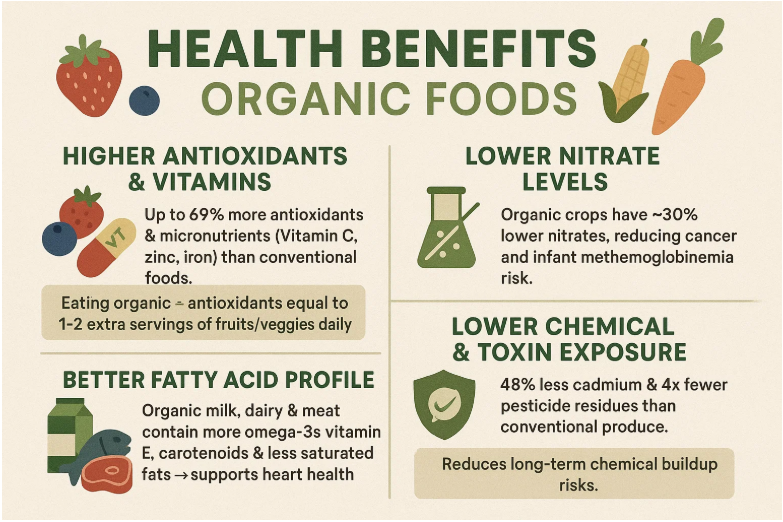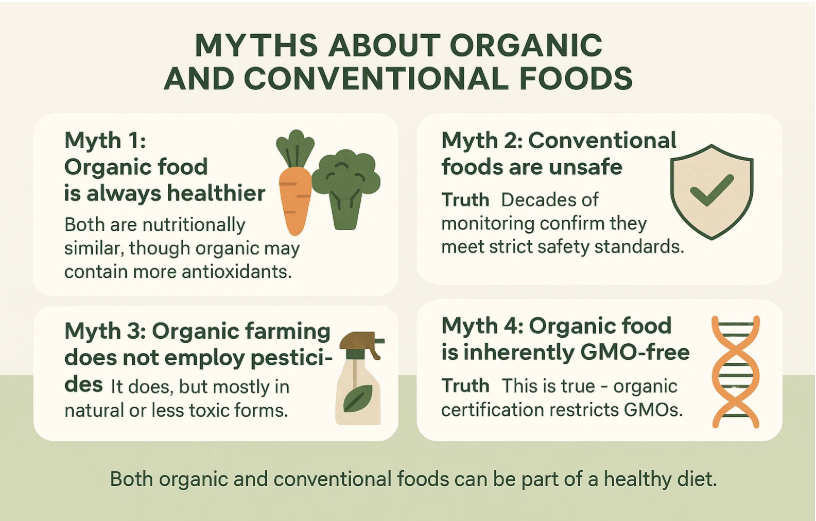Organic vs. Conventional Foods: Nutrition, Cost & Safety
When you visit the grocery store, you see thousands of different food items labeled with “organic foods” or “conventional foods.” The labels alone spark debate. Some claim organic food is healthier and more suitable to eat, while others argue conventional food products are just as safe and more affordable. So, what’s the exact truth? Let’s break down and decode the facts without the marketing hype.
What is Organic Food?
Organic food refers to those foods that are grown according to a given set of standards and guidelines that make them different from other conventional food types.
An organic food must:
- Be grown without the use of any pesticides, insecticides, fertilizers, or any other genetically modified crops.
- Follow natural farming practices that include crop rotation, biological pest control, and composting.
- Avoid using hormones or growth regulators to produce crops.
- Have a standardized certification label, such as USDA organic or, in India, PSG-India green or organic.
Key note: In simple words, Organic words describe the way food is grown and cultivated, and do not refer to the name of the food.
What are the Health benefits of Organic Foods?
Organic foods are grown naturally using old farming methods, and they are a rich source of vitamins and minerals. Here are some of the organic food benefits in detail. Depending upon the handling and crop productivity, there is mixed evidence suggesting more nutrition in organic foods than in non-organic foods.
-
Higher Antioxidants and Vitamins
Organic food contains more antioxidants and micronutrients like vitamin C, zinc, and iron, with antioxidant levels that can be up to 69% higher in organic crops. A 2003 study shows that organic berries and corn had ~ 58% more antioxidants and approximately 52% more vitamins.
Why are organic foods higher in antioxidants and Vitamins?
As they are cultivated using old conventional methods of farming that do not rely on pesticides, they naturally produce more protective compounds (antioxidants).
Keynote: Including organic fruits, vegetables, and cereals may provide antioxidants equal to 1-2 additional servings of fruits and vegetables per day.
-
Lower Nitrate Levels
Organic foods can have nitrate levels that are about 30% lower in organic crops, as high nitrate levels can increase the risk of certain cancers or Methemoglobinemia in infants (a condition affecting oxygen transport in blood).
-
Better Fatty Acid Profile
- Organic milk & dairy may contain higher levels of omega-3 fatty acids and slightly more iron, vitamin E, and carotenoids, but it may have less selenium and iodine, both essential minerals.
- Organic meat has been found to contain More omega-3 fatty acids and lower saturated fats, which reduces heart disease risk.
-
Lower Exposure to Chemicals and Resistant Bacteria
Many consumers prefer organic foods because they are free of pesticides and artificial fertilizers, with some studies also finding that organic produce contains 48% less cadmium (a toxic metal). Non-organic crops are likely to have 4 times more pesticide residues.
Even though conventional produce residues are within “safety limits,” long-term buildup of cadmium and chemicals is a concern.

What are Conventional Foods?
Foods that are produced by modern agricultural methods by using pesticides and synthetic fertilizers, and the most commonly consumed food, can also be genetically modified to improve disease resistance as well as crop resistance to varying climatic conditions like drought, etc.
Which food is safer? Nutritional or Organic
Foods, whether conventional or organic, have to follow strict safety standards. However, there are some important differences:
- Pesticide Residue: Organic food generally contains fewer pesticides than conventional food. Conventional foods may contain residues, but they are usually within government-approved safety limits.
- Irradiation (Food Radiation): Although organic foods cannot be irradiated, conventional foods can be irradiated to kill bacteria and pests and delay spoilage.
- Bacterial Contamination Risk: Both organic and conventional foods can be contaminated with harmful bacteria like E. coli O157:H7 and Salmonella typhimurium, which can cause typhoid. Food hygiene is essential, and food needs to be washed before peeling.
Does Conventional farming Impact the Environment?
Organic farming improves soil fertility and quality by reducing dependencies on pesticides, insecticides, and other chemicals, whereas conventional farming applies modern agricultural methods such as pesticides to produce crops with higher yields and quality.
That is why Organic farming is eco-friendly but can produce crops with low yield (20–25% less, which means more land is needed to grow the same amount of crop), while conventional farming feeds people with high efficiency.
Is Organic food more expensive than conventional food?
Organic food is 20-25% expensive than the normal conventional food; this is due to
- High Labour cost
- Lower yield than conventional farming
- Certificate and license expenditures
Conventional foods come with the advantages of low cost and high yield, which make them the most suitable food to eat worldwide.
Myths About Organic and Conventional Foods
Myth 1: Organic food is always healthier.
Not true—both are nutritionally similar, though organic may contain more antioxidants.
Myth 2: Conventional foods are unsafe.
Decades of monitoring have shown that conventional foods meet strict safety standards.
Myth 3: Organic farming does not employ pesticides.
It does, but mostly in natural or less toxic forms.
Myth 4: Organic food is inherently GMO-free.
This one is true: organic certification restricts GMOs.

Organic vs. Conventional food: Which food is best to eat?
Based on consumer priorities, one can have choices depending on their value.
- Health-conscious: Organic foods may have slightly reduced pesticide exposure if you are health-focused and can include them in your diet.
- Budget-focused: Conventional foods come with a low price and offer affordability and similar nutrition to that of organic foods.
- Eco-friendly: Organic foods cause less harm to soil health and fertility with reduced chemical exposure.
- Balanced approach: Based upon your needs, you can have a mix of both organic for select items and conventional for others.
Organic vs. Conventional Foods: Overview
| Parameter | Organic Foods | Conventional Foods | Overview |
| Farming Practices | Grown without synthetic pesticides, fertilizers, GMOs, or irradiation. Uses natural methods like crop rotation, composting, and biological pest control. | Uses synthetic fertilizers, pesticides, herbicides, and GMOs to increase yield and efficiency. | Organic focuses on natural sustainability; conventional prioritizes high productivity. |
| Pesticide Residue | Reduced pesticide residues; natural pesticides are permitted in limited quantities. | Higher likelihood of synthetic pesticide residues, albeit within government safety limits. | Both are regulated, but organic tends to reduce chemical exposure. |
| Nutritional Content | May contain slightly more antioxidants; vitamins and minerals are largely comparable to conventional. | Protein, vitamins, and minerals are all at similar levels. | The nutritional differences are minor, and diet quality is more important. |
| Food safety | It cannot be irradiated and may still contain bacteria like E. coli or Salmonella. | It can be irradiated to help prevent bacteria, pests, and spoilage. | Both can transmit bacteria, so proper handling is required. |
| Environmental Impact | Improves soil health and biodiversity while lowering pollution; lower yields may necessitate more land. | Higher yields feed more people but can cause soil degradation, water pollution, and chemical runoff. | Organic is eco-friendly but less efficient; conventional is efficient but heavier on the environment. |
| Cost | 20–50% more expensive due to labor, certification, and lower yields. | Generally cheaper and widely available. | Organic = premium price; conventional = budget-friendly. |
| Availability | Limited supply; not always accessible everywhere. | Widely available in supermarkets and local markets. | Conventional dominates global supply chains. |
| Consumer Choice | Seen as healthier, safer, and more ethical. | Sometimes viewed as less “clean,” despite being safe and regulated. | Perception drives organic sales, but safety is comparable. |
Key Takeaway
The truth about organic versus conventional foods is not black and white. Organic foods are more environmentally friendly, have lower pesticide levels, and may contain slightly more antioxidants, whereas conventional foods are less expensive, safer, and nutritionally equivalent. Ultimately, the healthiest option is a balanced diet rich in fruits, vegetables, and whole foods, regardless of label. Don’t worry about labels; instead, focus on variety, freshness, and consistency in your eating habits.
Frequently Asked Questions
Does washing, peeling, or cooking completely remove pesticide residues from food?
No, not entirely. Pesticide residues may remain inside the food; that’s why it is essential, while buying organic or conventional food, to wash it properly.
What factors influence the nutrient content of foods?
Factors such as soil quality, weather conditions, and harvest time, as well as animal genetics, diet, and season, can all affect the nutrient content of food.
What is the difference between organic and conventional food?
Organic foods are cultivated through old agricultural methods and make no use of any chemicals, while conventional food does. Organic ones contain more iron and zinc compared to conventional foods.
What are the benefits of eating organic food?
It helps reduce pesticide exposure, comes with a better fatty profile, is rich in vitamins and antioxidants, lowers the risk of antibiotic resistance, is eco-friendly in nature, meaning it preserves soil fertility, and promotes digestive and immune health.






